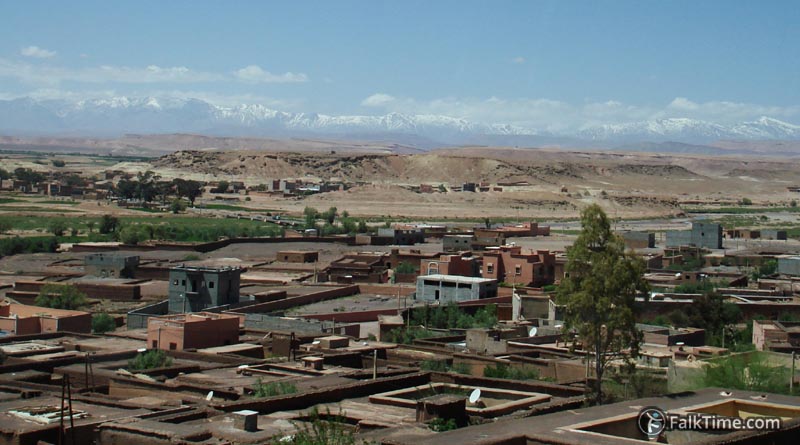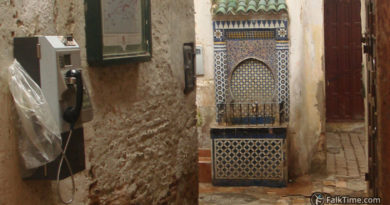Climate and weather
Morocco is a country where one can travel all year round. The season for journey depends on your aims. The first thing you should know about weather in Morocco is that the country has different climate zones. There are regions with high mountains that stay covered with snow until summer and different coasts: Atlantic and Mediterranean.
Next to Sahara desert (east and south of Morocco) you will meet semi-arid and desert climate. While most of coastal cities have Mediterranean and sub-Mediterranean climate. Mountain regions feature a variety of climate zones (up to alpine at highest peaks) that tend to be continental. The more you move to the south, the more continental becomes climate – hot summer, cool winter and a big difference between day and night temperatures. Similar climate can be found in Algeria, Spain, Portugal and California (USA).
Sightseeing tours are best from October to May, lazy beach trips – from May to October. Climbing up Toubkal mountain would be easier in summer season, otherwise you should be well equipped.
Swimming in Morocco is comfortable from May to October. Note: due to Canary Current the water of Atlantic coast of Morocco stays cool in summer – the temperature of water will be not more than +22°C. But in winter the temperature of water will be not less than +15°C. So if you need warm water, close to +36,6°C, Morocco won’t fit you. Sunbathing is possible all year round.
Coastal cities feature high humidity level (75-85%).
Weather in December, January and February
The winter in Morocco is humid – with rains (or snowfalls in some regions). It’s comfortable to walk in coastal cities and towns with warm and waterproof clothes on. The mountain pass from Fez to Sahara desert is covered with a thick layer of snow. In Fez +5…+16°C are awaited.
In winter one can go skiing or snowboarding in mountain regions of Morocco, f.e. in Ifrane. Unexpected activities for the country that exports oranges, right? Climbing up Toubkal mountain will turn into a toughness test – one should have right equipment and appropriate clothes – it can be up to -20°C on the top of Toubkal.
Weather in Rabat and Casablanca is cool, +6…+18°C. Sometimes it can be colder – even slight frosts and snow, but this happens very rare, not more than twice a winter.
Rivers and lakes are full of water. Some regions can suffer from freshets. In 2006 a freshet caused flood in Merzouga (yes, it is the desert).
Booking a room, I would recommend choosing a riad that has any heating options.
Weather in March and April
It would be hard to persuade yourself to go swimming to the ocean in spring: the air is not hot enough, while coastal wind blows continuously. Most of oueds (rivers that dry out for summer season) are already dry. Nevertheless March and April are best for walking and sightseeing. Trees are green and flowers are already blooming.
In Fez +10…+19°C are awaited. Be prepared to a big difference between night and day temperatures (~10 degrees). So if there’s no heating in riad or air-conditioner in your room, it can be quite cool at night.
It may rain in Rabat and Casablanca. The temperature in both cities is +12…+20°С. For your comfort I would advise to have a windproof jacket with you. Orange trees of Andalusian garden are covered in ripe oranges. And storks teach their nestlings to fly on Chellah ruins. Well, storks in Marrakech have the same worries. While night temperature in Marrakesh can be colder.
First rose buds appear in Kelaat M’Gouna, almonds and apricots have begun to grow on fruit trees. Fields are covered with fresh green grass.
Mountain peaks are still covered with snow, while the snow on mountain pass between Merzouga and Fez is almost gone. There’s no chance to go skiing in Ifrane.
The weather in Agadir, Legzira and Essaouira becomes warmer, +14…+22°С. One can walk knee-deep in oceanic water or go kitesurfing. In rural areas goats climb tasty argan trees to eat their leaves.
Dayet Srij lake in Merzouga has started to vanish. It depends on the year – some tourists find the already vanished lake in March, the other see last puddles of Dayet Srij in May. It’s quite windy in Sahara this time – dust storms usually happen in this period. The only thing one can do during a dust storm is to wait patiently in a hotel.
But it doesn’t mean that you should reject the plan of visiting desert in March or April – you may be lucky to meet no dust storms on your way.
Weather in Morocco in May
It’s time to start swimming. I remind you that the water is cool. Grass dries out in the sun and turns yellow. Nestlings became big storks. And all water sources that should dry out for summer period are already dry.
May in Morocco is good for sightseeing for those who like warm weather. The temperature in Fez, Agadir and Casablanca begins to rise, sometimes up to +30°С. People of Kelaat M’Gouna celebrate the beginning of rose petals harvest.
For more exact information about weather in Moroccan cities, I would advise you to track back archive information (for the month and city you need) for last 3-5 years from one of meteorological websites (that stores such information). This will help you to come closer to the real weather in the city that you intend to visit.
Weather in June, July, August and September
June-September is the official swimming season in Morocco. The temperature rises higher and higher. In coastal cities and towns it is still bearable, while next to Sahara desert the temperature is too high. It seems that you are in an oven. This brings to understanding of Moroccan mindset – why are the people in Morocco so leisurely.
The temperature of Atlantic coast is +26°…+32°C, in the south higher, than in the north. But if the dry wind (chergui) begins to blow from Sahara desert, the temperature will easily rise over +40°C. Chergui usually blows from 2 to 5 days.
Planning a trip to Sahara desert, note that there may be a big difference between day and night temperatures: +45°C in daytime can easily turn to +12°C in the night.
Summer walks in Fez are hard. Daytime temperature may exceed +35°C. Due to it Chouara tanneries smell like hell. One should rather stay in coastal settlements or try to find cooler weather hiking up the mountains.
Weather in Tangier is milder, +24°…+32°C. The water of Mediterranean sea is warmer.
No rains are awaited in these months.
Weather in October and November
The weather in October and November is good for sightseeing as in spring. By tempertures October reminds May and November – April and March. But all the nature will be totally different to what you may have seen in April – green fields have turned to dry savanna or even desert, mountains have no snowy peaks. But nights in Fez are not so cold and in mountain regions you may see a beautiful autumn leaf fall.
The ocean stays a little bit warm – so one may have more chances for swimming. Dust storms don’t disturb desert inhabitants. November is supposed to be the best time for visiting the desert.




